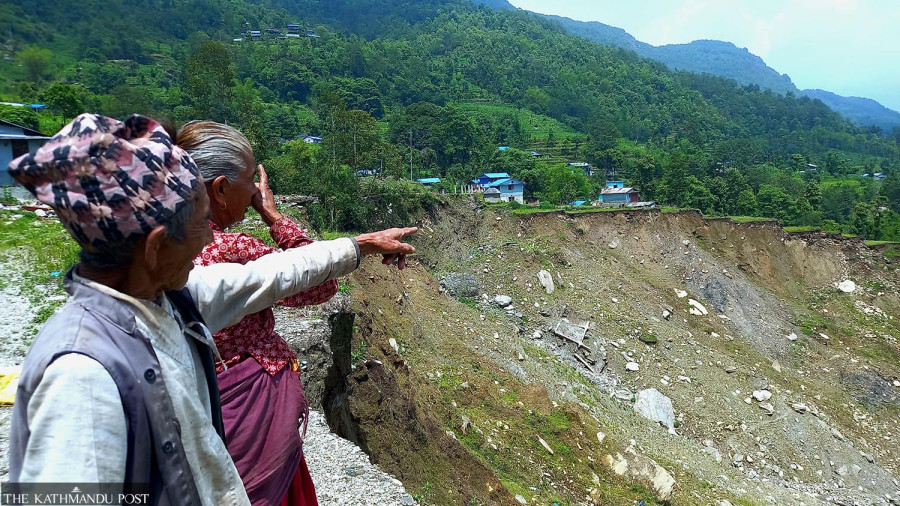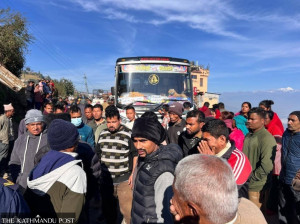Bagmati Province
Kalinchok locals live in fear of landslides every monsoon
Around 400 families are at risk. Residents are worried about safety as monsoon landslides have become more frequent over the last few years.
Kedar Shiwakoti
At this time of the year, locals of Lapilang village in Kalinchowk Rural Municipality in Dolakha would be found in their fields planting paddy and millet. However, for the past three years Tulasi Shrestha, a local woman, has been spending most of her time indoors as her farmland in the Raniban area was swept away by landslides last monsoon.
The Shrestha family depends on farming for their livelihood. With the farmland gone, the family is left with no reliable source of income, says Shrestha.
Having lost their only source of income had already made things difficult for the family, but what is more worrying for them is that this year’s monsoon has also put their house at high risk.
“The landslides took away the farmlands that provided food for us for the whole year and it is only a matter of time before they take this house as well,” said Shrestha.
In the past three years, Shrestha’s neighbours have left their homes in search of a safe place fearing landslides during the monsoon season, but she is adamant about staying behind.
“I will not leave this place even if a landslide sweeps away this house,” said Shrestha. “I have nowhere else to go, who will give me shelter? I am ready to die here.”
Like Tulasi, around 400 families of the rural municipality are at risk of Raniban landslides. With the onset of the monsoon, most of the residents have started looking for safer places for shelter as annual landslides have been increasing in frequency in the last few years, say locals.

The Lapilang village is surrounded by landslides on both sides and locals are in a state of panic as the stream that flows from above the settlement has been gradually shifting towards the village every year.
The landslide has also swept away the market area displacing many businesses.
Sunita Pandey, a local resident, said that the landslides in the Raniban area have been going on for the last four years.
“The landmass around my house has started collapsing due to landslides,” said Pandey. “Every rainy season, I leave the house and find safe shelter elsewhere with my children. We have been doing this for three years now.”
Pandey says that it has been three years since the villagers were told to move to a safe place, but they have received no assistance but only assurances from the authorities.
“The landslide has turned us into squatters,” Sunita said, “For the past three years, a number of people have been coming every year to see our condition and they give empty assurances that we would be moved to a safer place.”
In the year 2020-21, a landslide in the upper region of Lapilang washed away nine houses. The size of the landslide increased after the debris of the same landslide entered the stream. So far, 15 houses in the lower areas have been swept away by landslides. Most of the farmlands, which provide the locals with food throughout the year, have been turned into wasteland by landslides.

Rabin Khati, another local, says that he has been taking shelter at his relatives’ places for the last three years during the monsoon season as his land and house were swept away by last year’s landslide.”
“I became homeless after my shop and house in the market were swept away,” he said. “We were assured many times that we would be shifted to a safer location, but no one has provided us with any option for safer locations,” he said.
Khati says landslides over the years have damaged many houses in the village and when it rains the locals run to find shelter at safer places.
“Even the local government has failed to make arrangements for accommodation of disaster-prone villagers,” he said.
At present, the landslide has reached the upper part of the market area. Last year, the Bagmati provincial government allocated Rs24 million on wire netting to control the landslide. However, the seven-member consumer committee that was involved in the wire-netting allegedly misappropriated the funds. A case has also been filed against the members at the Commission for the Investigation of Abuse of Authority. However, action has yet to be taken against those involved in the embezzlement.

Ratna Bahadur Khadka, a landslide victim, said that even when there was proof that the consumer committee had endorsed the payment for the netting work before the work was completed, no one has been punished so far.
“Our farms and houses were taken away by the landslide, and for some people, this landslide is becoming a place to earn money,” said Khadka.
Khadka said that even though there were talks of installing an early landslide information system to warn about the landside, no work has been done to that end.
“We were even assured of being shifted to a safer location, but it still has not happened and we don’t know where, how and when we will be shifted,” Khadka said. “The number of people leaving their homes is increasing as homes are being swept away by landslides each year.”
Meanwhile, Kalinchowk Rural Municipality Chairman Arjun Prasad Shiwakoti said the provincial government has allocated Rs2.5 million for setting up shelter for the landslide victims.
“It is our responsibility to protect those who are affected by landslides and we are working towards that end,” said Shiwakoti, “but the rural municipality’s budget is not sufficient to work towards controlling the massive landslide.”
Shiwakoti said the local unit has been asking the provincial and federal government for assistance in the rehabilitation of the landslide-affected locals, but it all has fallen on deaf ears.




 7.12°C Kathmandu
7.12°C Kathmandu












